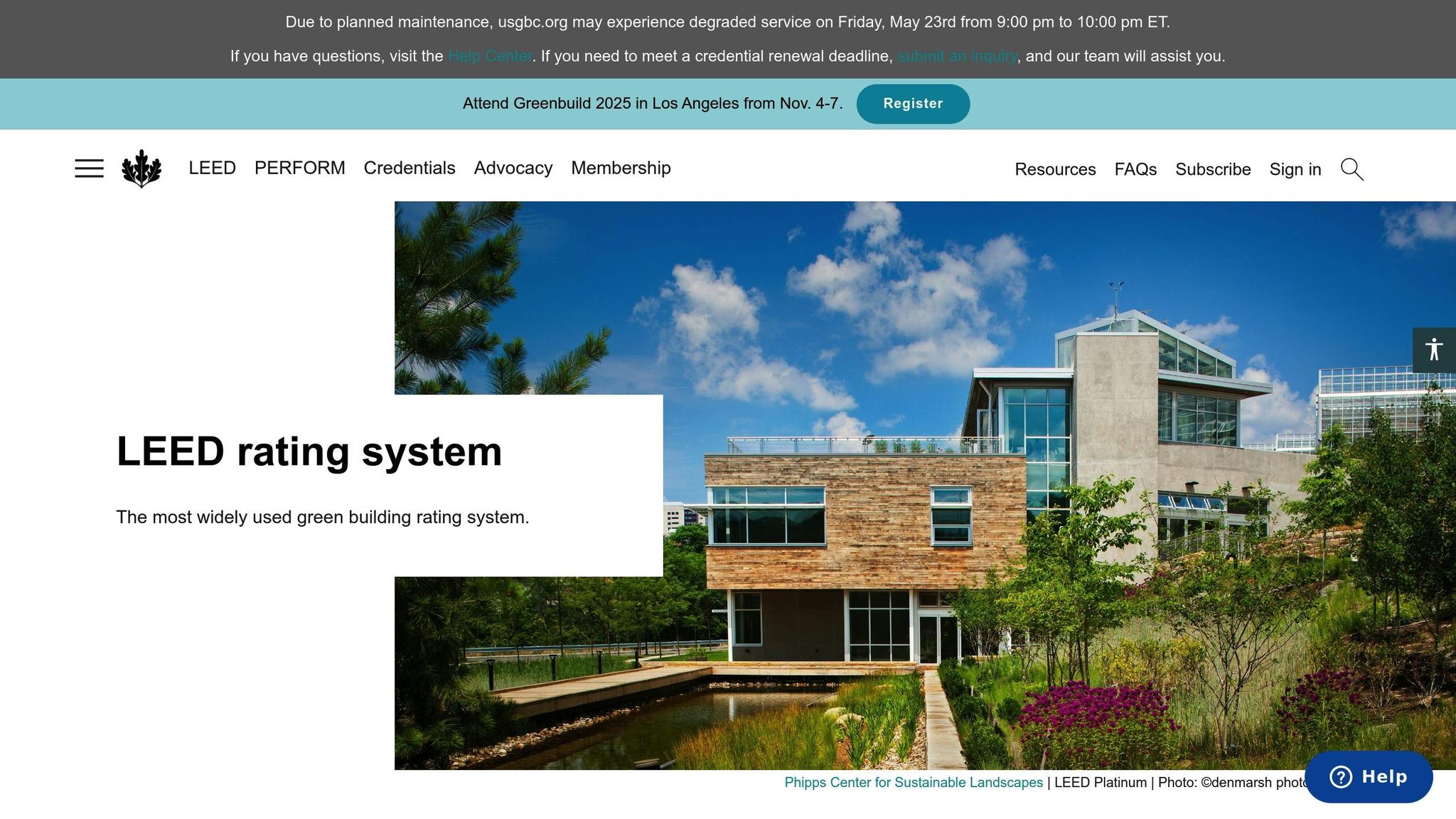Rainwater harvesting systems can help buildings save water, meet regulations, and earn certifications like LEED. Here's what architects need to know:
- Why It Matters: Water shortages affect 36% of cities, and rainwater systems can cut water use by up to 55% in commercial buildings.
- Key Code Areas:
- Storage: Tanks must be opaque, watertight, and screened to block debris.
- Filtration: Systems need multiple filters to ensure water quality.
- Overflow: Pipes must handle excess water safely and meet local rules.
- State Rules Vary:
- Texas: Tax breaks and no storage limits.
- California: Focus on non-potable uses like irrigation.
- Colorado: Strict 110-gallon cap for residential systems.
- Design Benefits: Systems reduce stormwater runoff, save energy, and help earn green building certifications.
Quick Tip: Always check local regulations before starting a project to ensure compliance and avoid delays.
Updated Rainwater Harvesting Systems Standard
Main Components of Rainwater Harvesting Codes
When architects dive into rainwater harvesting systems, understanding the key components of the codes is essential to ensure both safety and functionality. The 2022 CSA B805/ICC 805 standard serves as a detailed guide for designing and installing these systems, covering crucial aspects that directly impact architectural choices [7]. These standards transform regulations into actionable design specifications, helping architects not only meet code requirements but also push forward environmentally conscious design practices.
Collection and Storage Requirements
Storage containers for rainwater must meet strict standards to ensure safety and usability. Only new, ANSI/NSF-listed containers designed for potable water should be used. To prevent algae growth, containers must be opaque, and they should also be watertight with secure covers to keep out animals and unauthorized access. Additionally, screens at inlets and outlets are essential to block debris, insects, and small animals. Withdrawal systems must allow access to the water without requiring the container to be opened. Storage volume limits and additional permit requirements vary by location, especially for underground cisterns.
Filtration and Water Quality Standards
The level of water treatment depends on how the water will be used. For potable purposes, advanced filtration systems are essential. For instance, ultrafiltration technology is often employed to remove 99.9999% of bacteria and parasites, as well as 99.99% of viruses, ensuring the water meets high-quality standards. Codes typically require multiple filtration stages, including:
- First flush diverters to remove the initial runoff, which often contains the most contaminants.
- Screens at water inlets to block large debris.
- Post-storage filtration to handle finer particles and biological impurities.
Regular maintenance plays a big role in keeping these systems effective. Storage tanks should be cleaned twice a year, and accessible sampling ports must be included to allow for water quality testing.
Overflow and Distribution Requirements
Proper overflow management is vital to prevent property damage and stay within code guidelines. Overflow pipes must be designed to handle the flow rates of gutters, which could influence roof and gutter designs. Discharge from overflow pipes should be directed away from building foundations and is generally not permitted to flow onto impervious surfaces. Instead, it can be routed to rain gardens, water features, or secondary storage tanks.
For distribution systems, outlet pipes are typically installed at least 6 inches above the bottom of the cistern to avoid drawing in sediment. Pumps may be required to maintain adequate water pressure. To keep insects and vermin out, vent pipes, inlets, and overflow pipes need screens with openings no larger than 1/16 inch (1.6 mm). Some jurisdictions, such as the District of Columbia, require overflow pipes to have an area equal to or greater than the total area of all tank inlet pipes. Additionally, backwater valves with accessible service points must be installed on each overflow and drain pipe.
Collaborating early with engineers, architects, and officials ensures that systems meet these requirements and function smoothly.
State-by-State Differences in Rainwater Harvesting Codes
Rainwater harvesting is permitted across all 50 states, but the rules governing it can differ widely. These differences can significantly impact how systems are designed and implemented. Knowing the specific regulations in each state is essential for meeting local requirements and taking advantage of any available incentives. For architects, this means adapting designs to align with state-specific guidelines.
The variations in regulations often reflect regional water availability. In the water-rich Eastern states, the rules may be more relaxed, whereas in the arid Western states, stricter regulations and incentives aim to encourage water conservation.
Texas: Balancing Incentives and Flexibility
Texas is a leader in promoting rainwater harvesting, offering tax benefits and legal protections. For instance, the Texas Tax Code 151.355 provides a state sales tax exemption on rainwater harvesting equipment, reducing costs for clients. Additionally, Texas Property Code 202.007 ensures that homeowners associations cannot prohibit rainwater harvesting systems, making it easier to implement sustainable solutions in residential communities. On the public side, Texas House Bill 3391 requires new state buildings to incorporate rainwater harvesting technology, opening up opportunities for architects working on government projects.
California: Prioritizing Non-Potable Uses
California's rainwater harvesting policies emphasize non-potable applications like irrigation, toilet flushing, and cooling systems. The California Rainwater Capture Act of 2012 laid the groundwork for using rain barrels and catchment systems in both residential and commercial settings. In San Francisco, regulations go even further, requiring new developments over 100,000 square feet to include onsite water reuse systems. These systems must treat and repurpose greywater, rainwater, and blackwater for uses such as irrigation and toilet flushing.
Colorado: Water Rights and Usage Limits
Colorado's approach to rainwater harvesting is shaped by its water rights system, which prioritizes downstream users. Under House Bill 16-1005, passed in 2016, residential property owners can collect rainwater, but only in up to two containers with a combined capacity of 110 gallons. This limitation challenges architects to design systems that are both efficient and compact, focusing on immediate uses like garden irrigation. The cap also means these systems must be seamlessly integrated into building designs, both functionally and aesthetically.
| State | Key Regulation | Storage Limits |
|---|---|---|
| Texas | Tax exemptions, HOA protection | No specific limits |
| California | Rainwater Capture Act (2012) | Varies by jurisdiction |
| Colorado | House Bill 16-1005 (2016) | 110 gallons maximum |
Understanding these state-specific rules is crucial for architects working on projects across multiple states. Tailoring designs to meet these varying requirements ensures compliance and maximizes the effectiveness of rainwater harvesting systems.
Combining Rainwater Harvesting with Design Goals
When architects align their design objectives with rainwater harvesting codes, they can achieve regulatory compliance while significantly boosting sustainability. These systems not only enhance a building’s environmental performance but also deliver notable financial advantages. In fact, commercial projects have shown that rainwater harvesting can yield impressive returns on investment.
Earning LEED Credits and Sustainability Incentives

Rainwater harvesting systems are a direct pathway to earning LEED and WELL certification points, making them a smart choice for sustainable building projects. For example, LEED-certified buildings typically use 25% less energy and 11% less water compared to non-certified structures, proving the tangible benefits of these systems. Many state-specific codes align with these certification standards, offering architects an additional layer of compliance benefits.
Take the Bullitt Center in Seattle: its 56,000-gallon cistern meets 100% of the building’s water needs. Similarly, projects like Microsoft's Silicon Valley Campus and Maracanã Stadium have shown that integrated rainwater systems can save millions of gallons of municipal water while slashing water utility costs by up to 40%.
By incorporating rainwater harvesting, architects can seamlessly blend aesthetics with functionality. These systems not only help earn certification points but also play a critical role in managing stormwater effectively.
Stormwater Management Benefits
Rainwater harvesting goes beyond water conservation - it’s also a powerful tool for tackling urban runoff and easing the strain on municipal stormwater systems. This dual-purpose approach addresses two pressing urban issues: water scarcity and flood management, while aligning with municipal stormwater guidelines often outlined in state codes.
For instance, the Edinburgh Gardens Raingarden in Melbourne eliminates 16,000 kilograms of suspended particles annually and provides irrigation for 60% of the park’s existing trees. At Xuhui Runway Park in Shanghai, rain gardens harvest and treat stormwater runoff, filtering out pollutants and storing water for irrigation.
Technological advancements have made these systems even more effective. Amsterdam's smart blue–green roofs use sensors and weather data to manage water levels, releasing stored water ahead of heavy rainfall to make room for new precipitation. Meanwhile, Climate Tiles in Copenhagen capture rainwater from roofs and sidewalks, redirecting 30% more water compared to traditional systems.
The versatility of rainwater harvesting systems allows them to fit projects of all sizes and urban settings. Unlike centralized municipal water systems, these decentralized solutions serve multiple purposes: they supplement water supplies, replace potable water for non-drinking needs, and reduce stormwater runoff. By integrating these systems, architects not only elevate sustainability efforts but also simplify urban water management challenges.
sbb-itb-1be9014
Documentation and Approval Process
Securing permits for rainwater harvesting systems calls for thorough preparation. Knowing the requirements in advance can save both time and frustration by avoiding unnecessary delays.
Required Documents for Permits
The permit application process demands detailed documentation to demonstrate technical accuracy and regulatory compliance. At the core of this process are construction documents, which are essential for permit approval. Rainwater harvesting systems require additional technical details compared to standard plumbing plans.
Here’s what your permit package should include:
- System Description and Design Narrative: This section should explain how the rainwater harvesting system integrates into the building's overall water management strategy. It should also outline the system's functionality.
- List of Intended End Uses: Clearly specify how the harvested rainwater will be used - whether for irrigation, toilet flushing, cooling towers, or other non-potable purposes. These details are critical because regulations often vary depending on the intended use.
- Technical Drawings: Include a site plan, piping diagram, and wiring schematics. The site plan and piping diagram should map out all components, water flow paths, municipal connections, and overflow routes. Wiring schematics are needed for systems that use pumps, controls, or monitoring tools.
- System Specification and Bill of Materials: Provide a complete list of components, including manufacturer details, model numbers, and technical specifications. This helps officials confirm that the equipment complies with local standards.
- Water Safety Plans: Updated plans must outline monitoring protocols, testing schedules, and procedures for addressing contamination risks. These plans ensure that water quality is maintained throughout the system's operation.
- Operations and Maintenance Manual: This document serves as both a requirement and a practical resource for operators. It should cover standard operating procedures, startup and shutdown processes, and emergency protocols for system failures.
"Rainwater systems are typically allowed, particularly for outdoor irrigation (and often without a permit) in much of the United States. Indoor, potable use of rainwater is the most challenging system to get a permit for." - Greywater Action
In many cases, jurisdictions require a professional engineer to be involved in the design of larger systems or those intended for potable use. Stamped drawings and calculations from an engineer often form part of the permit package.
Water quality testing may also be required during the approval process, especially for potable systems. Proper documentation not only helps secure permits but also ensures a compliant and sustainable design.
Multi-State Compliance Considerations
Beyond documentation, architects and designers must navigate varying state regulations, particularly for projects spanning multiple states. Water laws differ by state, meaning a design that works in one location may need significant adjustments in another.
Success in multi-state compliance starts with early research and a conservative design approach. Consult each state’s regulations before finalizing system plans. Requirements can vary widely - even between neighboring states. For instance, some states require permits for any rainwater harvesting, while others allow collection without permits for specific uses. Volume restrictions, often tied to prior appropriation laws, can further complicate designs.
The CSA B805/ICC 805-2018 Standard for Rainwater Harvesting Systems offers a useful framework for navigating multi-state compliance. Many states reference this standard in their regulations, providing a consistent foundation for system design.
Financial incentives also vary by state and can influence decisions about system size and design. For projects across multiple states, consider modular designs that can be adjusted to meet local requirements. Each jurisdiction should have its own dedicated permit package, with clear references to the applicable codes and regulations.
During the research phase, reach out to multiple agencies, including zoning, fire, building, and health departments. Early coordination with these groups can help avoid conflicts later in the process.
Although many states are moving toward more favorable regulations for rainwater harvesting, changes occur at different rates. Staying updated on evolving rules across jurisdictions is essential throughout the design and construction phases.
Conclusion: Main Points for Architects
Rainwater harvesting codes are constantly adapting to tackle the challenges of water scarcity and urban expansion. For architects, understanding these regulations goes beyond mere compliance - it's about designing solutions that are both resilient and mindful of public health while making strides in environmental responsibility.
The CSA B805:22/ICC 805:2022 standard is a key resource for architects. It lays out the essential guidelines for designing and installing rainwater harvesting systems, forming the backbone of what most jurisdictions require. As Dwayne Torrey, Director of Construction and Infrastructure Standards at CSA Group, puts it:
"This Standard seeks to make it easier for jurisdictions to accept and approve rainwater harvesting systems on a much wider scale than has previously been possible".
Beyond the technical framework, local regulations play a pivotal role in shaping designs. Regional differences often mean that a system designed for Texas may not align with Colorado's water rights laws, or that California's emphasis on non-potable water use might diverge from other states' priorities. Early research into local requirements can prevent unnecessary redesigns and costly delays.
Rainwater harvesting systems offer more than just water savings. They ease the burden on stormwater infrastructure and reduce freshwater demand. These systems can also help achieve LEED credits and other green building certifications. Consider this: the average American household uses about 300 gallons of water daily, and treating and delivering the nation's 340 billion gallons of water each day consumes over 56 billion kilowatt-hours of electricity annually. The potential for savings - both in resources and energy - is enormous.
When preparing permit packages, ensure they meet the specific documentation standards for each jurisdiction. For projects spanning multiple states, this means creating tailored permit packages that reference the applicable local codes.
Take inspiration from projects like the Edinburgh Gardens Raingarden, which successfully integrates rainwater harvesting with stormwater management. Such projects highlight how technical compliance can go hand in hand with environmental performance and creative design.
To excel in rainwater harvesting design, architects must balance technical accuracy with forward-thinking creativity. Staying informed about changing regulations and collaborating early with local authorities ensures designs meet immediate project goals while supporting broader sustainability objectives. By aligning with these evolving codes, architects can keep innovation and sustainability at the heart of their work.
FAQs
How can architects ensure their rainwater harvesting systems meet state regulations?
Architects looking to comply with state-specific rainwater harvesting regulations should start by thoroughly researching the laws and guidelines in their project’s location. This means understanding the necessary permits, any restrictions, and potential incentives tied to rainwater collection systems. For instance, states like Colorado and Arkansas have distinct rules that often require professional involvement and alignment with local plumbing codes.
Beyond state regulations, architects should also factor in national standards like the CSA B805/ICC 805-2018, which provides best practices for designing and installing rainwater harvesting systems while prioritizing health and safety. By staying up-to-date on both state and national requirements, architects can design systems that not only comply with the law but also work efficiently for their specific projects.
What are the main advantages of including rainwater harvesting systems in building designs beyond saving water?
Why Include Rainwater Harvesting in Building Designs?
Adding rainwater harvesting systems to building designs offers more than just water conservation - it brings a host of practical and environmental benefits. For starters, these systems reduce stormwater runoff, which helps prevent soil erosion and stops harmful pollutants, like pesticides and fertilizers, from washing into nearby rivers and streams. By controlling runoff, they play a role in maintaining healthier ecosystems and supporting local wildlife.
Rainwater harvesting also boosts water reliability, especially during droughts or emergencies. It ensures access to water even when municipal supplies are limited. On top of that, building owners can see lower utility bills, ease the burden on local water infrastructure, and contribute to preserving regional water supplies. It's a win-win for both the environment and your wallet.
What documents do you need to get a permit for a rainwater harvesting system?
To get permits for a rainwater harvesting system, you'll usually need to provide several important documents, such as:
- Site plans that detail the location and layout of your system.
- Engineering specifications for all components involved in the system.
- Documentation proving compliance with local plumbing and building codes.
- A maintenance plan explaining how the system will be operated and maintained.
- An environmental impact assessment, if your local authorities require one.
Keep in mind that these requirements can vary significantly based on where you live, especially if your system has a capacity of more than 5,000 gallons. It's smart to check with your local permitting office to ensure you meet all the necessary guidelines.


